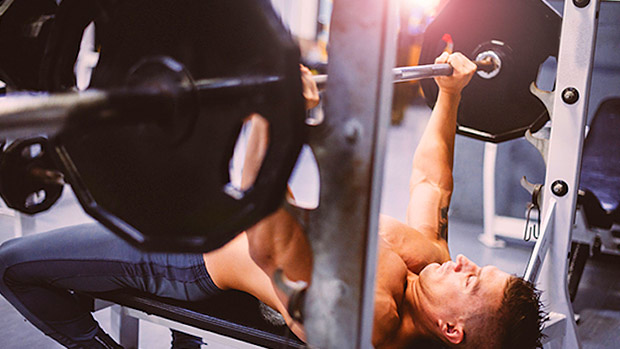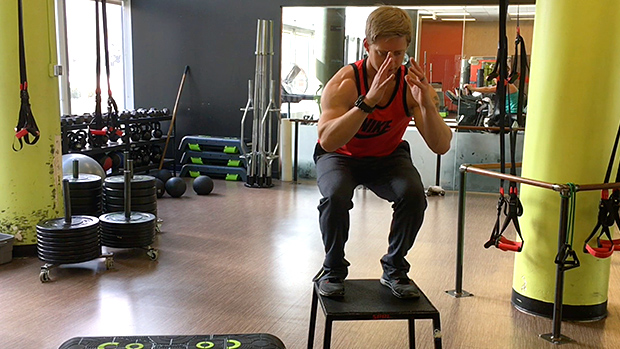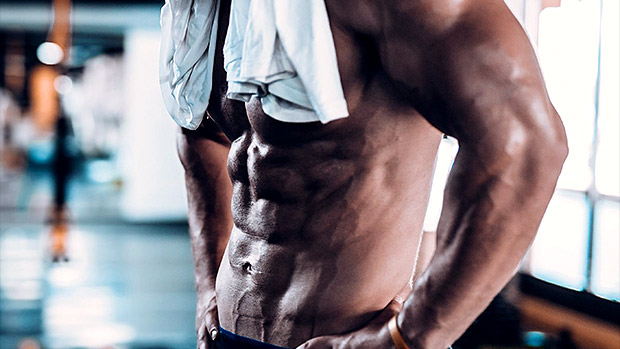Look Great, Perform Even Better
People that look and perform like muscular athletes usually do two things in the gym:
- They train to improve performance by driving up strength, speed, and conditioning.
- They use specific hypertrophy work to attack weak points and, ultimately, build a balanced physique.
But the problem among most people is that they treat aesthetics (looking good) and athleticism (performing well) as mutually exclusive training goals.
Fortunately, they don't have to be – especially when you use and adjust the training methods of the late Olympic sprint coach, Charlie Francis. While Francis wasn't programming workouts to help his athletes look better naked or bust a deadlift PR, his high-low principle is what kept them progressing without burning out.
We can use the same idea to increase both performance and hypertrophy. Here's an overview of what that looks like before I get into the details.
It's also called an "intensive-extensive" or a "high-low" training split. It bases workouts on the neurological demand of training. It places the highest-demand work on nonconsecutive days.
The "heavy" or intensive days are when you do exercises that are more demanding on the central nervous system. For lifting, this can mean that the work is greater in complexity, has greater explosive demands, or requires max strength.
The "light" or extensive training days are based on a higher volume and less weight. To keep the workout challenging without such extreme neural demands, this will mean creating more metabolic stress within your muscles.

1 You get stronger and look better at the same time.
This programming allows you to train muscles and movement patterns more frequently. For many lifters, this results in improved technique and, as a result, faster gains in strength compared to training a muscle or movement pattern once per week.
You also get the bonus of consistency. Organizing workouts in a way that keeps you from digging yourself into a recovery hole will allow you to keep training and keep challenging your body without burning out.
You can't change your body composition or gain strength without consistent effort and that's what this type of training guarantees.
2 You feel good and stay fresh from workout to workout.
The reason this type of program works is because of its varying neurological demands, which keep systemic stress in check. You'll be able to squat, deadlift, etc. more often, but you must vary the loading and volume to prevent excess fatigue.
To understand it better you'll need to know a couple things about the nervous system. Let's cover that...
Your nervous system has two parts:
- The central nervous system (CNS), composed of the brain and the spinal cord.
- The peripheral nervous system (PNS), all the remaining nerves and ganglia outside of the brain and spinal cord.
Motor units consist of one motor neuron and all the muscle fibers it stimulates. When a signal is sent from the nervous system, it activates the motor unit. Then all the muscle fibers innervated by the motor unit are stimulated and contract.
Each motor unit consists of a bundle of muscle fibers and a motor neuron. Small fibers are in small bundles and in control of smaller, finite movements. Large muscle fibers are in bigger bundles to generate maximum power and strength.
So when you unrack a weight at 95% of your 1RM, your nervous system goes into overdrive, sending massive signals to your body to increase muscular recruitment.
Motor neurons, and virtually every other nerve in your body, are constantly receiving information from other nerves. As a result, it becomes supercharged, recruiting more muscle fibers to execute the near-max squat, along with improving muscle fiber recruitment on subsequent exercises, making them more effective.
That means lifting heavy all the time is best, right? Nope. If you lifted heavy every workout, your nervous system, joints, and tissues would start screaming at you before too long.
That's where this programming shines. It limits the overall stress you're placing on your body by adjusting the demands on your CNS by varying load, speed, and intent of exercises.
3 You improve your technique.
With heavy-light training you do each movement pattern more often than most training splits.
When it comes to maximizing your performance, the more often you do a movement correctly, the more proficient you'll become. Once a movement becomes more naturally and technically precise, your strength numbers can improve, driving up work capacity, which will lead to improvements in your physique.
Remember when you first started deadlifting and you had to learn the mechanics of the movement? While you were deadlifting you'd think things like, "Don't round your back and pull the slack out of the bar."
But with lots of repetition using good technique, you get the movement down pat. Reaching this state of "unconscious competence" in the gym allows you narrow your focus and maximize performance.
Heavy-light training can help lifters of all levels become more proficient at the highly technical lifts by increasing the training frequency of each one.
4 You gain more muscle.
The more often you train a muscle the more protein synthesis you'll trigger. Protein synthesis is the fundamental biological process by which cells build their specific proteins, and your muscles grow through this process.
Studies have shown protein synthesis responds to resistance training and lasts about 24-48 hours after a workout (1, 2). The more often you train a muscle – with adequate recovery time – the more consistent protein synthesis will be.
With heavy-light training, you can actually vary the loading and train muscles on back-to-back days. You can hit heavy squats on your intensive day and follow up with high-rep goblet squats the following day.
The result is increased protein synthesis while adding enough variation to allow muscles to recover and mitigate overuse injuries, which leads to more muscle growth and better performance in the gym.

It works best with a four to six day training split. Obviously, as training frequency increases, your focus on recovery must too. Otherwise you'll be working harder with less to show for it.
Here's a sample split for six days per week.
- Monday: Intensive – Compound Lifts
- Tuesday: Extensive – Back and Biceps
- Wednesday: Intensive – Compounds Lifts
- Thursday: Extensive – Chest and Triceps
- Friday: Intensive – Compound Lifts
- Saturday: Extensive – Legs and Shoulders
Monday (Intensive)
| Exercise | Sets | Reps | Rest | |
|---|---|---|---|---|
| A1 | Box Jump | 4 | 3 | 1 min. |
| A2 | Power Clean | 4 | 2 | 2 min. |
| B | Front Squat | 4 | 5 | 2 min. |
| C | Incline Barbell Press | 5 | 5 | 2 min. |
| D | Chin-Up | 4 | 6-8 | 90 sec. |
Tuesday (Extensive, Back and Bi's)
| Exercise | Sets | Reps | Rest | |
|---|---|---|---|---|
| A1 | Cable Face-Pull with External Rotation | 4 | 12 | 15 sec. |
| A2 | Dumbbell Y-Raise | 4 | 12 | 15 sec. |
| B | Single-Arm Dumbbell Row | 5 | 8-10/side | 45 sec. |
| C1 | Lat Pulldown or Wide Grip Pull-Up | 4 | 8 | 30 sec. |
| C2 | Dumbbell Alternating Biceps Curl | 4 | 8-10 | 1 min. |
| D | Wide Grip Seated Cable Row | 4 | 12 | 90 sec. |
| E | Alternating Dumbbell Hammer Curl | 4 | 8-10/side | 1 min. |
Wednesday (Intensive)
| Exercise | Sets | Reps | Rest | |
|---|---|---|---|---|
| A1 | Broad Jump | 4 | 2 | 45 sec. |
| A2 | Single Leg Hip Thrust | 4 | 8/leg | 45 sec. |
| B | Deadlift | 5 | 1-3 | 3 min. |
| C | Close-Grip Bench Press | 5 | 5/4/3/2/1 | 3 min. |
| D | Pendlay Row | 4 | 6 | 90 sec. |
Thursday (Extensive, Chest and Tris)
| Exercise | Sets | Reps | Rest | |
|---|---|---|---|---|
| A1 | Cable Chest Flye | 3 | 12 | 45 sec. |
| A2 | Subscap Push-Up | 3 | 12 | 30 sec. |
| B | One-Arm Dumbbell Bench Press | 2 | 6/side | 90 sec. |
| C | Dumbbell Incline Bench Press | 4 | 10/8/6/20 | 1 min. |
| After the set of six, just cut the weight in half and bang out 20 reps. | ||||
| D | Dumbbell Pullover | 3 | 12-15 | 45 sec. |
| E1 | Dumbbell Overhead Triceps Extension | 3 | 12 | 30 sec. |
| E2 | Feet Elevated Push-up | 2 | failure | 1 min. |
| F | Cable Straight-Arm Pushdown | 2 | 20 | 1 min. |
Friday (Intensive)
| Exercise | Sets | Reps | Rest | |
|---|---|---|---|---|
| A | Dumbbell Squat Jump | 3 | 4 | 90 sec. |
| B | Back Squat or Trap Bar Deadlift | 4 | 6/4/2/2 | 2 min. |
| C | Barbell Military Press | 5 | 5 | 2 min. |
| D | TRX Inverted Row | 4 | 12 | 1 min. |
| E | Hanging Leg Raise | 4 | 10 | 1 min. |
Saturday (Extensive Legs, shoulders)
| Exercise | Sets | Reps | Rest | |
|---|---|---|---|---|
| A1 | Stability Ball Hamstring Curl | 3 | 8-10 | 45 sec. |
| A2 | Stability Ball Lockout | 3 | 1 min. | 45 sec. |
| B | Dumbbell Bulgarian Split Squat | 3 | 6/leg | 90 sec. |
| C | Single-Arm Dumbbell Shoulder Press | 3 | 8/arm | 90 sec. |
| D1 | Dumbbell Single-Leg RDL | 3 | 10/leg | 1 min. |
| D2 | Skater Squat | 3 | 10/leg | 1 min. |
| E1 | Dumbbell Lean-Away Lateral Raise | 2 | 8 | |
| E2 | Dumbbell Lateral Raise | 2 | 10 | |
| E3 | Overhead Plate Raise (25 pound plate) | 2 | 15 | 1 min. |
| F | Goblet Squat (Use half your bodyweight) | 1 | 25 |
Go home, you're done.

For Athletes
For those athletically inclined who want a bit more, any speed work or specific technical work you want to add would go on the intensive days before lifting to preserve technique. You may do better to limit your training to five days and allow adequate recovery.
Cardio Additions
Daily 30-minute walks are a failsafe method to burn a few extra calories and provide a low-stress cardiovascular training method. Should you want to add more, keep it low volume and do it on the intensive day at least six hours after your lifting session. Beware though, you'll likely need to decrease your training volume to fit this in, both from a time and recovery perspective.
For the Beaten-Up Lifter
Feel free to switch out Olympic lifting variations for an additional jump or medicine ball throw, like a medicine ball back toss. In all cases, find the lifts that best fit your body without beating the snot out of your joints.
- Damas F et al. Resistance Training-Induced Changes in Integrated Myofibrillar Protein Synthesis Are Related to Hypertrophy Only after Attenuation of Muscle Damage. J Physiol. 2016 Sep 15;594(18):5209-22. PubMed.
- Brook MS et al. Skeletal Muscle Hypertrophy Adaptations Predominate in the Early Stages of Resistance Exercise Training, Matching Deuterium Oxide-Derived Measures of Muscle Protein Synthesis and Mechanistic Target of Rapamycin Complex 1 Signaling. FASEB J. 2015 Nov;29(11):4485-96. PubMed.





